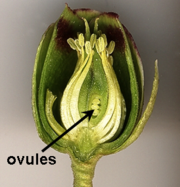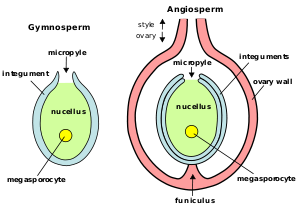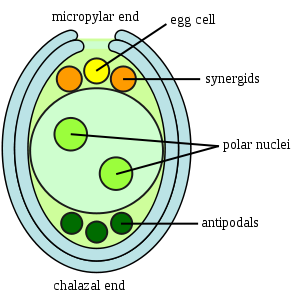
Ovule
Encyclopedia

Ovum
An ovum is a haploid female reproductive cell or gamete. Both animals and embryophytes have ova. The term ovule is used for the young ovum of an animal, as well as the plant structure that carries the female gametophyte and egg cell and develops into a seed after fertilization...
". In seed plants, the ovule is the structure that gives rise to and contains the female reproductive cells. It consists of three parts: The integument(s) forming its outer layer(s), the nucellus (or megasporangium
Sporangium
A sporangium is an enclosure in which spores are formed. It can be composed of a single cell or can be multicellular. All plants, fungi, and many other lineages form sporangia at some point in their life cycle...
), and the megaspore-derived female gametophyte (or megagametophyte) in its center. The megagametophyte (also called embryo sac in flowering plants) produces an egg cell
Ovum
An ovum is a haploid female reproductive cell or gamete. Both animals and embryophytes have ova. The term ovule is used for the young ovum of an animal, as well as the plant structure that carries the female gametophyte and egg cell and develops into a seed after fertilization...
(or several egg cells in some groups) for fertilization. After fertilization, the ovule develops into a seed
Seed
A seed is a small embryonic plant enclosed in a covering called the seed coat, usually with some stored food. It is the product of the ripened ovule of gymnosperm and angiosperm plants which occurs after fertilization and some growth within the mother plant...
.
Location within the plant
In flowering plants, the ovule is typically located inside, the organ of the flowerFlower
A flower, sometimes known as a bloom or blossom, is the reproductive structure found in flowering plants . The biological function of a flower is to effect reproduction, usually by providing a mechanism for the union of sperm with eggs...
called the gynoecium
Gynoecium
Gynoecium is most commonly used as a collective term for all carpels in a flower. A carpel is the ovule and seed producing reproductive organ in flowering plants. Carpels are derived from ovule-bearing leaves which evolved to form a closed structure containing the ovules...
. The ovary
Ovary (plants)
In the flowering plants, an ovary is a part of the female reproductive organ of the flower or gynoecium. Specifically, it is the part of the pistil which holds the ovule and is located above or below or at the point of connection with the base of the petals and sepals...
of the gynoecium produces the ovules and ultimately becomes the fruit
Fruit
In broad terms, a fruit is a structure of a plant that contains its seeds.The term has different meanings dependent on context. In non-technical usage, such as food preparation, fruit normally means the fleshy seed-associated structures of certain plants that are sweet and edible in the raw state,...
wall. Flowers may have one or multiple ovules per ovary. The ovules are attached to placenta in the ovary through a structure known as the funiculus
Funiculus
The cerebrospinal fibers consist of numerous nerve fibers collected together and enclosed in membranous sheaths. A small bundle of fibers, enclosed in a tubular sheath, is called a funiculus; if the nerve is of small size, it may consist only of a single funiculus; but if large, the funiculi are...
, the plant equivalent of an umbilical cord
Umbilical cord
In placental mammals, the umbilical cord is the connecting cord from the developing embryo or fetus to the placenta...
. Different patterns of ovule attachment, or placentation
Placentation
In biology, placentation refers to the formation, type and structure, or arrangement of placentas. The function of placentation is to transfer nutrients from maternal tissue to a growing embryo...
, can be found among plants.
In gymnosperm
Gymnosperm
The gymnosperms are a group of seed-bearing plants that includes conifers, cycads, Ginkgo, and Gnetales. The term "gymnosperm" comes from the Greek word gymnospermos , meaning "naked seeds", after the unenclosed condition of their seeds...
s such as conifers and similar plants, the ovules are typically borne on the surface of an ovuliferous (ovule-bearing) scale, usually within an ovulate cone
Conifer cone
A cone is an organ on plants in the division Pinophyta that contains the reproductive structures. The familiar woody cone is the female cone, which produces seeds. The male cones, which produce pollen, are usually herbaceous and much less conspicuous even at full maturity...
(also called megastrobilus
Strobilus
A strobilus is a structure present on many land plant species consisting of sporangia-bearing structures densely aggregated along a stem. Strobili are often called cones, but many botanists restrict the use of the term cone to the woody seed strobili of conifers...
).
In some extinct plants (e.g. Pteridosperms), megasporangia and perhaps ovules were borne on the surface of leaves. In other extinct taxa, a cupule (a modified leaf or part of a leaf) surrounds the ovule (e.g. Caytonia or Glossopteris.
Ovule parts and development

Zygote
A zygote , or zygocyte, is the initial cell formed when two gamete cells are joined by means of sexual reproduction. In multicellular organisms, it is the earliest developmental stage of the embryo...
and then embryo
Embryo
An embryo is a multicellular diploid eukaryote in its earliest stage of development, from the time of first cell division until birth, hatching, or germination...
of the next sporophyte
Sporophyte
All land plants, and some algae, have life cycles in which a haploid gametophyte generation alternates with a diploid sporophyte, the generation of a plant or algae that has a double set of chromosomes. A multicellular sporophyte generation or phase is present in the life cycle of all land plants...
generation. In flowering plants, a second sperm nucleus fuses with other nuclei in the megagametophyte forming a typically polyploid (often triploid) endosperm
Endosperm
Endosperm is the tissue produced inside the seeds of most flowering plants around the time of fertilization. It surrounds the embryo and provides nutrition in the form of starch, though it can also contain oils and protein. This makes endosperm an important source of nutrition in human diet...
tissue, which serves as nourishment for the young sporophyte.
Integuments, chivai and chalaza
An integument is a protective cell layer surrounding the ovule. Gymnosperms typically have one integument (unitegmic) while angiosperms typically have two (bitegmic). The evolutionary origin of the integuments, especially the second integument typical of angiosperms remains obscure. The inner integument (which is integral to the formation of ovules from megasporangia) has been proposed to have formed from sterile branches surrounding a terminal megasporangium. Elkinsia, a preovulate taxon, has a lobed structure fused to the lower third of the megasporangium, with the lobes extending upwards in a ring around the megasporangium. This might, through fusion between lobes and between the structure and the megasporangium, have produced an integument.The origin of the second or outer integument has been an area of active contention for some time. The cupules of some extinct taxa have been suggested as the origin of the outer integument. A few angiosperms produce vascular tissue in the outer integument, the orientation of which suggests that the outer surface is morphologically abaxial. This suggests that Caytoniales or Glossopteridales cupules may have produced the outer integument of angiosperms.
The integuments develop into the seed coat when the ovule matures after fertilization.
The integuments do not enclose the nucellus completely but leave an opening at its apex referred to as the micropyle
Micropyle
A micropyle is small opening in the surface of an ovule, through which the pollen tube penetrates, often visible as a small pore in the ripe seed....
. The micropyle opening allows pollen
Pollen
Pollen is a fine to coarse powder containing the microgametophytes of seed plants, which produce the male gametes . Pollen grains have a hard coat that protects the sperm cells during the process of their movement from the stamens to the pistil of flowering plants or from the male cone to the...
to enter the ovule for fertilization. In gymnosperms (e.g., conifers), the pollen
Pollen
Pollen is a fine to coarse powder containing the microgametophytes of seed plants, which produce the male gametes . Pollen grains have a hard coat that protects the sperm cells during the process of their movement from the stamens to the pistil of flowering plants or from the male cone to the...
itself is drawn into the ovule and the micropyle opening closes after pollination. In angiosperms, only a pollen tube enters the micropyle. During germination
Germination
Germination is the process in which a plant or fungus emerges from a seed or spore, respectively, and begins growth. The most common example of germination is the sprouting of a seedling from a seed of an angiosperm or gymnosperm. However the growth of a sporeling from a spore, for example the...
, the seedling
Seedling
thumb|Monocot and dicot seedlingsA seedling is a young plant sporophyte developing out of a plant embryo from a seed. Seedling development starts with germination of the seed. A typical young seedling consists of three main parts: the radicle , the hypocotyl , and the cotyledons...
's radicle
Radicle
In botany, the radicle is the first part of a seedling to emerge from the seed during the process of germination. The radicle is the embryonic root of the plant, and grows downward in the soil...
emerges through the micropyle.
Located opposite from the micropyle is the chalaza
Chalaza
The chalaza is a structure inside bird and reptile eggs and plant ovules. It attaches or suspends the yolk or nucellus within the larger structure.-In animals:...
where the nucellus is joined to the integuments. Nutrients from the plant travel through the phloem
Phloem
In vascular plants, phloem is the living tissue that carries organic nutrients , in particular, glucose, a sugar, to all parts of the plant where needed. In trees, the phloem is the innermost layer of the bark, hence the name, derived from the Greek word "bark"...
of the vascular system to the funiculus and outer integument and from there apoplastically
Apoplast
Within a plant, the apoplast is the free diffusional space outside the plasma membrane. It is interrupted by the Casparian strip in roots, air spaces between plant cells and the cuticula of the plant....
and symplastically
Symplast
The symplast of a plant is the inner side of the plasma membrane in which water can freely diffuse.The plasmodesmata allow the direct flow of small molecules such as sugars, amino acids, and ions between cells...
through the chalaza to the nucellus inside the ovule. In chalazogamous plants, the pollen tubes enter the ovule through the chalaza instead of the micropyle opening.
Nucellus, megaspore and perisperm
The nucellus (plural: nucelli) is the central portion of the ovule inside the integuments. It functions as a megasporangiumSporangium
A sporangium is an enclosure in which spores are formed. It can be composed of a single cell or can be multicellular. All plants, fungi, and many other lineages form sporangia at some point in their life cycle...
. In immature ovules, the nucellus contains a megasporocyte (megaspore mother cell), which undergoes sporogenesis
Sporogenesis
Sporogenesis is the production of spores in biology. The term is also used to refer to the process of reproduction via spores. Reproductive spores are formed in many eukaryotic organisms, such as plants, algae and fungi, during their normal reproductive life cycle...
via meiosis
Meiosis
Meiosis is a special type of cell division necessary for sexual reproduction. The cells produced by meiosis are gametes or spores. The animals' gametes are called sperm and egg cells....
. Three of the four haploid spores produced in meiosis typically degenerate, leaving one surviving megaspore inside the nucellus, but in some cases more survive. After fertilization, the nucellus may develop into the perisperm that feeds the embryo. In some plants, the diploid tissue of the nucellus can give rise to a seed through a mechanism of asexual reproduction
Asexual reproduction
Asexual reproduction is a mode of reproduction by which offspring arise from a single parent, and inherit the genes of that parent only, it is reproduction which does not involve meiosis, ploidy reduction, or fertilization. A more stringent definition is agamogenesis which is reproduction without...
called nucellar embryony
Nucellar embryony
Nucellar embryony is a form of seed reproduction that occurs in certain plant species, including many citrus varieties. During the development of seeds from plants that possess this genetic trait, the nucellar tissue which surrounds the megagametophyte can produce additional embryos which are...
.
Megagametophyte


Gametophyte
A gametophyte is the haploid, multicellular phase of plants and algae that undergo alternation of generations, with each of its cells containing only a single set of chromosomes....
, called the megagametophyte.
In gymnosperms, the megagametophyte consists of around 2000 nuclei and forms archegonia
Archegonium
An archegonium , from the ancient Greek ἀρχή and γόνος , is a multicellular structure or organ of the gametophyte phase of certain plants, producing and containing the ovum or female gamete. The archegonium has a long neck canal and a swollen base...
, which produce egg cells for fertilization.
In flowering plants, the megagametophyte (also referred to as the embryo sac) is much smaller and typically consists of only seven cells and eight nuclei. This type of megagametophyte develops from the megaspore through three rounds of mitotic
Mitosis
Mitosis is the process by which a eukaryotic cell separates the chromosomes in its cell nucleus into two identical sets, in two separate nuclei. It is generally followed immediately by cytokinesis, which divides the nuclei, cytoplasm, organelles and cell membrane into two cells containing roughly...
divisions. The cell closest to the micropyle opening of the integuments differentiates into the egg cell, with two synergid cells by its side that are involved in the production of signals that guide the pollen tube. Three antipodal cells form on the opposite (chalazal) end of the ovule and later degenerate. The large central cell of the embryo sac contains two polar nuclei.
Zygote, embryo and endosperm
The pollen tube releases two spermSperm
The term sperm is derived from the Greek word sperma and refers to the male reproductive cells. In the types of sexual reproduction known as anisogamy and oogamy, there is a marked difference in the size of the gametes with the smaller one being termed the "male" or sperm cell...
nuclei into the ovule. In gymnosperms, fertilization occurs within the archegonia produced by the female gametophyte. While it is possible that several egg cells are present and fertilized, typically only one zygote
Zygote
A zygote , or zygocyte, is the initial cell formed when two gamete cells are joined by means of sexual reproduction. In multicellular organisms, it is the earliest developmental stage of the embryo...
will develop into a mature embryo
Embryo
An embryo is a multicellular diploid eukaryote in its earliest stage of development, from the time of first cell division until birth, hatching, or germination...
as the resources within the seed are limited.
In flowering plants, one sperm nucleus fuses with the egg cell to produce a zygote, the other fuses with the two polar nuclei of the central cell to give rise to the polyploid (typically triploid) endosperm
Endosperm
Endosperm is the tissue produced inside the seeds of most flowering plants around the time of fertilization. It surrounds the embryo and provides nutrition in the form of starch, though it can also contain oils and protein. This makes endosperm an important source of nutrition in human diet...
. This double fertilization is unique to flowering plants, although in some other groups the second sperm cell does fuse with another cell in the megagametophyte to produce a second embryo. The plant stores nutrients such as starch
Starch
Starch or amylum is a carbohydrate consisting of a large number of glucose units joined together by glycosidic bonds. This polysaccharide is produced by all green plants as an energy store...
, protein
Protein
Proteins are biochemical compounds consisting of one or more polypeptides typically folded into a globular or fibrous form, facilitating a biological function. A polypeptide is a single linear polymer chain of amino acids bonded together by peptide bonds between the carboxyl and amino groups of...
s, and oil
Oil
An oil is any substance that is liquid at ambient temperatures and does not mix with water but may mix with other oils and organic solvents. This general definition includes vegetable oils, volatile essential oils, petrochemical oils, and synthetic oils....
s in the endosperm as a food source for the developing embryo and seedling, serving a similar function to the yolk of animal eggs. The endosperm is also called the albumen of the seed.

